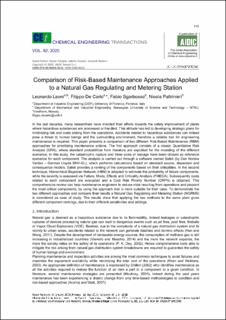| dc.contributor.author | Leoni, Leonardo | |
| dc.contributor.author | De Carlo, Filippo | |
| dc.contributor.author | Sgarbossa, Fabio | |
| dc.contributor.author | Paltrinieri, Nicola | |
| dc.date.accessioned | 2022-05-03T12:19:10Z | |
| dc.date.available | 2022-05-03T12:19:10Z | |
| dc.date.created | 2020-11-16T09:31:52Z | |
| dc.date.issued | 2020 | |
| dc.identifier.citation | Chemical Engineering Transactions. 2020, 82 115-120. | en_US |
| dc.identifier.issn | 1974-9791 | |
| dc.identifier.uri | https://hdl.handle.net/11250/2993930 | |
| dc.description.abstract | In the last decades, many researchers have directed their efforts towards the safety improvement of plants where hazardous substances are processed or handled. This attitude has led to developing strategic plans for minimizing risk and costs arising from the operations. Accidents related to hazardous substances can indeed pose a threat to human beings and the surrounding environment, therefore a reliable tool for engineering maintenance is required. This paper presents a comparison of two different Risk-Based Maintenance (RBM) approaches for prioritizing maintenance actions. The first approach consists of a classic Quantitative Risk Analysis (QRA), where standard probabilities from literature are exploited for the modeling of the different scenarios. In this study, the catastrophic rupture and three sizes of leakage have been chosen as reference scenarios for each component. The analysis is carried out through a software named Safeti (by Den Norske Veritas – German Lloyds DNV-GL), which performs calculations based on standard source, dispersion and consequence models. Safeti provides a ranking of the components based on their criticalities. In the second technique, Hierarchical Bayesian Network (HBN) is adopted to estimate the probability of failure components, while the severity is assessed via Failure, Mode, Effects and Criticality Analysis (FMECA). Subsequently costs related to each component are evaluated and a Cost Risk Priority Number (CRPN) is obtained. This comprehensive review can help maintenance engineers to reduce risks resulting from operations and pinpoint the most critical components, by using the approach that is more suitable for their case. To demonstrate the two different approaches and compare their results a Natural Gas Regulating and Metering Station (NGRMS) is considered as case of study. The results show that applying the two methods to the same plant gives different component rankings, due to their different sensitivities and settings. | en_US |
| dc.language.iso | eng | en_US |
| dc.publisher | The Italian Association of Chemical Engineering (AIDIC) | en_US |
| dc.rights | Navngivelse 4.0 Internasjonal | * |
| dc.rights.uri | http://creativecommons.org/licenses/by/4.0/deed.no | * |
| dc.title | Comparison of risk-based maintenance approaches applied to a natural gas regulating and metering station | en_US |
| dc.title.alternative | Comparison of risk-based maintenance approaches applied to a natural gas regulating and metering station | en_US |
| dc.type | Peer reviewed | en_US |
| dc.type | Journal article | en_US |
| dc.description.version | publishedVersion | en_US |
| dc.source.pagenumber | 115-120 | en_US |
| dc.source.volume | 82 | en_US |
| dc.source.journal | Chemical Engineering Transactions | en_US |
| dc.identifier.doi | 10.3303/CET2082020 | |
| dc.identifier.cristin | 1848187 | |
| cristin.ispublished | true | |
| cristin.fulltext | original | |
| cristin.qualitycode | 1 | |

